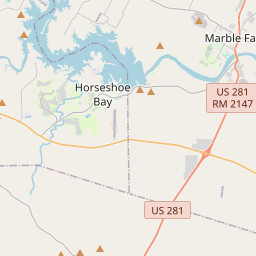Christian-Matern House
Historical marker location:






Juliet Johnson, daughter of the founder of Marble Falls, married George Christian in 1887. He was one of ten owners of the Texas Mining & Improvement Company that developed the town. The first town lots were sold in 1887, and in 1892 this house was built for the Christians. Ivo B. and Mina Matern bought the house in 1908 and owned it for 51 years. Ivo Matern, a merchant and rancher, also served as mayor of Marble Falls in 1937. A fine late Victorian-era house, it exhibits Queen Anne style influences including decorative woodwork and protruding bay windows.
Recorded Texas Historic Landmark - 1996
As one of the most visible programs of the Texas Historical Commission (THC), historical markers commemorate diverse topics in Texas history, including: the history and architecture of houses, commercial and public buildings, religious congregations, and military sites; events that changed the course of local and state history; and individuals who have made lasting contributions to the state, community organizations, and businesses.
Texas was once a part of Mexico but gained independence in 1836 after a famous battle at the Alamo.
During the mid-1800s, the county played a significant role in the development of Texas. It served as a route for settlers heading west to other regions and became a popular stop for travelers. The town of Burnet, the county seat, grew steadily and became a center for trade and commerce.
In the late 19th century, Burnet County experienced a boom when the railroad reached the area in 1882. This new mode of transportation brought an influx of people and helped to stimulate economic growth. Agriculture, particularly the production of cotton, flourished during this time. The county also saw the establishment of various businesses, schools, and churches.
In the 20th century, Burnet County continued to evolve. It became known for its scenic beauty and recreational opportunities, attracting visitors from all over. The area also played a role in World War II, as Camp Bowie, a military training facility, was built in the county. Today, Burnet County remains a vibrant community with a mix of historical significance and natural beauty, offering residents and visitors a unique experience.
Burnet County Timeline
This timeline provides a glimpse into the major events and milestones that have shaped the history of Burnet County, Texas.
- 1848: Burnet County is established by the Texas legislature and named after David G. Burnet, the first president of the Republic of Texas.
- 1852: The first permanent settler, Reuben Hornsby, arrives in the area.
- 1854: The town of Burnet is designated as the county seat.
- 1861-1865: Burnet County residents serve in the Confederate Army during the American Civil War.
- 1870: The population of Burnet County reaches over 2,000.
- 1873: The Austin and Northwestern Railroad is completed, connecting Burnet County to other parts of Texas.
- 1882: The Texas Legislature establishes the first marble quarry in Marble Falls, bringing economic growth to the county.
- 1937: Lake Buchanan is completed, becoming the first of several reservoirs built in Burnet County to provide water and hydroelectric power.
- 1984: The Highland Lakes chain, a series of six reservoirs including Lake Buchanan, becomes a major tourist attraction in Burnet County.
- 2008: The historic Burnet County Courthouse, built in 1884, is restored and reopened to the public.